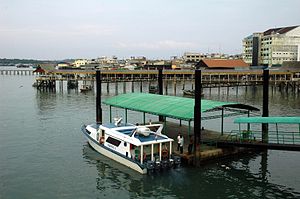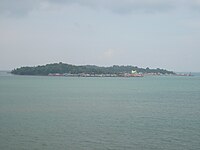Tanjungpinang
Kota Tanjung Pinang | |
|---|---|
| Other transcription(s) | |
| • Jawi | تنجوڠ ڤينڠ |
| • Chinese | 丹戎槟榔 |
| • Pinyin | Dān róng bīn láng |
 Port of Tanjung Pinang | |
| Motto: Jujur Bertutur Bijak Bertindak | |
 Location in Bintan | |
| Coordinates: 1°5′0″N 104°29′0″E / 1.08333°N 104.48333°E | |
| Country | Indonesia |
| Province | Riau Islands |
| Government | |
| • Mayor | H. Lis Darmansyah |
| • Deputy | Drs. H. Syahrul, S. Pd |
| Area | |
| • Total | 812.7 km2 (313.8 sq mi) |
| Elevation | 18 m (59 ft) |
| Population | |
| • Total | 225,086 |
| • Density | 236.8/km2 (613.1/sq mi) |
| Time zone | UTC+7 (WIB) |
| Area code | +62 771 |
| Website | www |
| Tanjungpinang | |||||||||||||||
|---|---|---|---|---|---|---|---|---|---|---|---|---|---|---|---|
| Traditional Chinese | 丹戎檳榔 | ||||||||||||||
| Simplified Chinese | 丹戎槟榔 | ||||||||||||||
| |||||||||||||||
Template:Contains Chinese text Tanjung Pinang (Jawi: تنجوڠ ڤينڠ ; Chinese: 丹戎槟榔; pinyin: Dān róng bīnláng) is the capital and second-largest city of Riau Islands, a province of Indonesia. It has roughly 200,000 residents and serves as a trading port for islands in the Riau Archipelago.
Tanjung Pinang – whose name is taken from the position of a beech tree that juts into the sea – occupies a strategic location on the south of Bintan Island, guarding the mouth of the Bintan River. Tanjung Pinang has ferry and speedboat connections to Batam, Singapore (40 km away), and Johor Bahru.
Over the centuries, Tanjung Piang came under the control of Sumatra, China, Malacca, the Netherlands, Britain, and Japan. These contacts each influenced its culture, also being a centre of Malay culture and trade traffic. In the 18th century, it was a capital of the Johor–Riau–Lingga Empire.
History
The name Tanjung Pinang is taken from the position of beach nut tree that juts into the sea.[further explanation needed] Trees that are in the Cape which is a guide for voyagers who will go to Bintan River.[clarification needed] The Tanjung Pinang River is the entrance to Bintan, where the Bentan empire[clarification needed] was based in what is now the subdivision of Bukit Batu.
Early history
Tanjung Piang's history can be traced to the early 3rd century, when it flourished as a trading post on the India–China trade route. Srivijaya, a Sumatra-based empire which nurtured trade with China, came to dominate much of the Malay archipelago from the 7th to 13th centuries. It declined with the rise of piracy in the region, and by the 12th century Bintan Island became known by the Chinese as "Pirate Island".
According to the Malay Annals, a Srivijaya prince named Seri Teri Buana, fleeing from the sacking of Palembang, stayed on Bintan for several years, gathering his strength before founding the Kingdom of Singapura (Singapore). A century later, it too was sacked by rival powers, and its king founded a new city at Malacca. The Malacca Sultanate (1400–1511) became one of the great empires of the region, its territories including the Riau Archipelago. Malacca was captured by the Portuguese in 1511, and the exiled Sultan Mahmud Shah established his capital at Bintan, from which he organized attacks and blockades against the Portuguese. In 1526, after a number of attempts to suppress the Malay forces, the Portuguese razed Bintan to the ground.
Johor Sultanate
Alauddin Riayat Shah II, a son of Mahmud Shah, established the Johor Sultanate in 1528. Former-Malaccan territories were quickly brought under Johor's influence, including Bintan, where an important trading port called Bandar Riau was opened. As it prospered and a war with Jambi threatened Johor in 1722, the capital was moved to Riau (now Tanjung Pinang) which became a centre of trade and Islamic studies much as Malacca had been.
A conflict with the Dutch, who had taken Malacca from the Portuguese, culminated with a Dutch fleet of 13 vessels besieging and attacking Riau. On 6 January 1784, they were met in battle by Malay and Bugis forces, and repelled with the destruction of the Dutch command ship Malaka's Wal Faren. Malay forces continued to harass the Dutch, and blockaded Malacca, but a defeat and succession crisis shifted power against them. The capital was moved from Riau to Lingga in 1788. The change of capitals has led to the Johor Sultanate sometimes being called the Johor–Riau–Lingga Empire.
The British gained control of Malacca from the Dutch in 1795. Attempting to increase their influence over the Straight of Malacca, the two powers each crowned a different candidate as Sultan of Johor–Riau during a succession crisis (1812–1818). This led to the partition of Johor–Riau under the Anglo-Dutch Treaty of 1824, which placed the territory south of the straight under Dutch control as the Riau–Lingga Sultanate.
Dutch colony and independence

The Malay were not consulted in these agreements, and relations worsened. On 11 February 1911, the Dutch deposed the sultan for defying the colonial masters, and officially annexed the sultanate which was then administered from Tanjung Pinang as the Riau Residency of the Dutch East Indies. A military base was also constructed at Tanjung Pinang.
During World War II, the Japanese occupiers made Tanjung Pinang the government centre for the Riau Islands. Control returned to the Dutch following the Japanese surrender, and the Dutch officially withdrew in 1950. Riau became one of the last territories merged into Indonesia, known as the daerah-daerah pulihan (recovered regions). Tanjung Pinang briefly became the capital of Riau Province, until the capital was moved to Pekanbaru in 1960. A law passed in 2001 defined Tanjung Pinang as an autonomous city, and it became the capital of Riau Islands Province.
Administration
The city is divided into four districts (kecamatan), tabulated below with their 2010 Census population:[1]
| Name | Population |
|---|---|
| Bukit Bestari | 54,157 |
| Tanjungpinang Timur (East Tanjung Pinang) |
70,867 |
| Tanjungpinang Kota (City) |
17,026 |
| Tanjungpinang Barat (West Tanjung Pinang) |
45,309 |
Landmarks

The cultural center for stage performances of Malay music and dances is located in Tanjung Pinang. The centre regularly organises festivals and other performances, such as music and dance. Renowned Buddhist temples are located outside central Tanjung Pinang in a small town named Senggarang.
Penyengat Island

The old ruler's palace and royal tombs, including the grave of Raja Ali Haji (who was the creator and author of the first Malay grammar book), are one of the many legacies left by the Riau–Lingga Sultanate. The old vice-royal mosque, the Masjid Raya, is still in use.
Notes
- ^ Biro Pusat Statistik, Jakarta, 2011.
External links
 Tanjung Pinang travel guide from Wikivoyage
Tanjung Pinang travel guide from Wikivoyage- Official website

